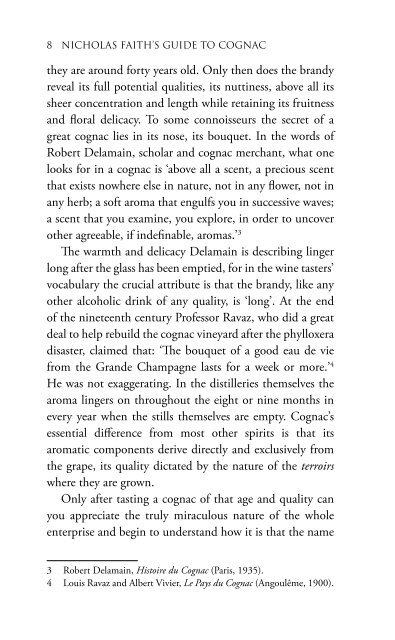You also want an ePaper? Increase the reach of your titles
YUMPU automatically turns print PDFs into web optimized ePapers that Google loves.
they are around forty years old. Only then does the brandy<br />
reveal its full potential qualities, its nuttiness, above all its<br />
sheer concentration and length while retaining its fruitness<br />
and floral delicacy. To some connoisseurs the secret of a<br />
great cognac lies in its nose, its bouquet. In the words of<br />
Robert Delamain, scholar and cognac merchant, what one<br />
looks for in a cognac is ‘above all a scent, a precious scent<br />
that exists nowhere else in nature, not in any flower, not in<br />
any herb; a soft aroma that engulfs you in successive waves;<br />
a scent that you examine, you explore, in order to uncover<br />
other agreeable, if indefinable, aromas.’ 3<br />
The warmth and delicacy Delamain is describing linger<br />
long after the glass has been emptied, for in the wine tasters’<br />
vocabulary the crucial attribute is that the brandy, like any<br />
other alcoholic drink of any quality, is ‘long’. At the end<br />
of the nineteenth century Professor Ravaz, who did a great<br />
deal to help rebuild the cognac vineyard after the phylloxera<br />
disaster, claimed that: ‘The bouquet of a good eau de vie<br />
from the Grande Champagne lasts for a week or more.’ 4<br />
He was not exaggerating. In the distilleries themselves the<br />
aroma lingers on throughout the eight or nine months in<br />
every year when the stills themselves are empty. <strong>Cognac</strong>’s<br />
essential difference from most other spirits is that its<br />
aromatic components derive directly and exclusively from<br />
the grape, its quality dictated by the nature of the terroirs<br />
where they are grown.<br />
Only after tasting a cognac of that age and quality can<br />
you appreciate the truly miraculous nature of the whole<br />
enterprise and begin to understand how it is that the name<br />
3 Robert Delamain, Histoire du <strong>Cognac</strong> (Paris, 1935).<br />
4 Louis Ravaz and Albert Vivier, Le Pays du <strong>Cognac</strong> (Angoulême, 1900).<br />
of a small town in western France has become synonymous<br />
with the finest distilled liquor in the world. As a result,<br />
<strong>Cognac</strong> is by far the best-known French town, Paris alone<br />
excepted. A typical story concerns a session of an Episcopal<br />
Council. 5 According to the legend Mgr Cousseau, the<br />
Bishop of Angoulême, was chatting to neighbours from<br />
far-off sees, from North America to Ireland, none of whom<br />
had ever heard of his diocese, that is, until he explained that<br />
he was the Bishop of <strong>Cognac</strong>. The whole assembly, bishops,<br />
archbishops and cardinals immediately exclaimed ‘what a<br />
great bishopric’.<br />
Yet even today <strong>Cognac</strong> has only 30,000 inhabitants, and<br />
when it first rose to fame in the eighteenth century fewer<br />
than 2,000 people sheltered within its walls. Whatever the<br />
town’s size, the reputation of its brandy would have been a<br />
prodigious achievement, for anyone with access to grapes<br />
and the simplest of distillation apparatus can make brandy<br />
of a sort. But only the <strong>Cognac</strong>ais can make cognac, a drink<br />
with qualities that are enhanced by age until it becomes the<br />
very essence of the grapes from which it was distilled.<br />
The success of the <strong>Cognac</strong>ais is due to a multitude of<br />
factors – a combination of geography, geology and history.<br />
They had the perfect soil, the right climate and the ability to<br />
market their products to appreciative customers the world<br />
over. At first sight nothing about <strong>Cognac</strong>, a small town in<br />
the middle of an agreeable, albeit unremarkable, landscape,<br />
is special. Yet a more detailed investigation reveals that<br />
almost everything about the region is out of the ordinary.<br />
The most obvious distinction is geological, as it is for the<br />
sites producing all of France’s finest wines and spirits. But<br />
5 Ardouin-Dumazet, Voyage en France (Paris, 1898).


